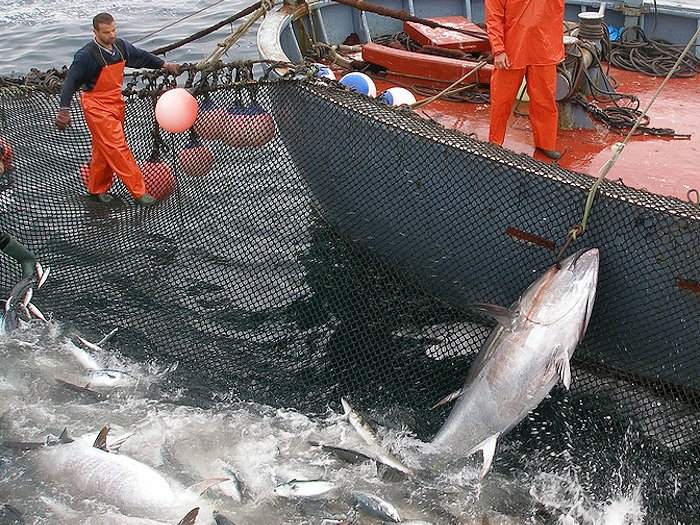
If you’re lucky enough to have bought an apartment at La Manga Club, you’ll have already discovered 1,001 wonders surrounding you: beautiful landscapes, impressive architectural works, and home-grown culinary delicacies. And among these delicacies you’ve surely come across mojama or singular dishes like melva empanada. Perhaps what you don’t know is that these products are the fruit of a centuries-old fishing art: almadraba. This technique has slowly disappeared in most parts of Spain but is still in use around the La Azohía region of Cartagena and in the Andalusian province of Cádiz. Environmentally-aware fishermen in these areas prefer this selective and sustainable technique that follows the migration of tuna from the Atlantic Ocean to the Mediterranean Sea. The construction of a labyrinth of cloth nets close to the coastline, between April and June, is all they need to bring home a great catch while still ensuring the health and survival of these species.
The word “almadraba” comes from the Greek “mandrague”, specifically from “mandra”, meaning “park”, and “aqua”, or “water”. The Moors transformed the term, ending up with today’s “almadraba”, with the meaning, “a place to strike or fight.” The first references to this fishing art can be dated to the time of Aristotle, Pliny, and Strabo, because the Phoenicians, Greeks, Carthaginians, and later the Romans, all used the technique. One testament to this are the archaeological ruins located on various walkways around La Azohía. Some time later, in the XVI Century, they built the Tower of Santa Elena, armed with two cannons to fight back the frequent attacks of Berber pirates. By this time, after the Christian Reconquest, the sea became a locus of instability, causing many fishermen to abandon almadraba. It was only a brave few that continued to risk their lives to capture red tuna on a large scale.
Despite the difficulties, close to your apartment at La Manga Club, this almadraba tradition is still alive and practiced, using tools including cloth nets, chains, cables, lines, and anchors distributed in five different sections – the cuadro, the legítima, the copo, the rabera de tierra, and the rabera de fuera – to intercept the tuna as they migrate into the Mediterranean. The raberas are cloth nets placed perpendicular to the coastline that act as a barrier to direct the fish and that eventually hoist them onto the boats. This artisanal type of fishing is sustainable because as it is carried out near the coastline, it catches fewer fish, and the holes in the cloth are like a second filter, letting only the largest fish into the trap. What’s more, the fish are brought onto the boats alive, allowing for a second selection and rejection of small fish or those that cannot be sold. Red tuna can weigh up to 200 kilos, but almadraba fishermen also seek other species, such as melva, albacore, and greater amberjack.
In the middle of the XIX century, there were more than 30 almadrabas in Murcia, Andalusia, Catalonia, the Valencian Community, the Balearic Islands, and Ceuta, but the reduction in capture volume and the high costs of operation have resulted in its decline everywhere but places like Isla Plana, in La Azohía, and the aforementioned Cádiz. In 2016, more than 107,000 kilos of fish were caught using this technique, generating revenues of more than 375,000 Euros, and almadraba in La Azohía, listed in the fishing records since 1866, generates 20 direct jobs for six months of the year.
Much more than just a technique, almadraba is ancient history that lives on, and an opportunity to explore the past very close to your apartment at La Manga Club. Between April and June, you can see fishermen in action, committed to these traditional techniques and to bringing food to our table responsibly and sustainably. And most importantly, if you want to buy some of the fruit of their labour, these fish will be labelled clearly as caught with artisanal almadraba methods. Or if you prefer someone else to prepare it for you, ask for them in the great restaurants in the vicinity of your property at La Manga Club!
Recent posts
-
08/12/25
Celebrate the 1200th anniversary of the city of Murcia from your property at La Manga Club
- 10/11/25
- 23/10/25
-
14/09/25
Thinking of buying property at La Manga Club? These 7 insights might just convince you
-
10/08/25
Looking for a day out from your home at La Manga Club? Visit the Ricote Valley and Cieza
-
18/07/25
Las Acacias: Buying a Luxury Villa in Spain’s Premier Golf Resort
-
23/06/25
Buying Property in La Manga Club: Discover the 5 Must-See Highlights of the Calblanque Regional Park
-
15/05/25
Dive just minutes from your La Manga Club home: the Islas Hormigas Marine Reserve